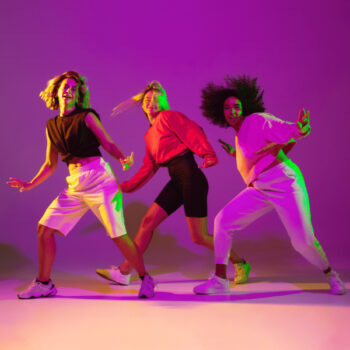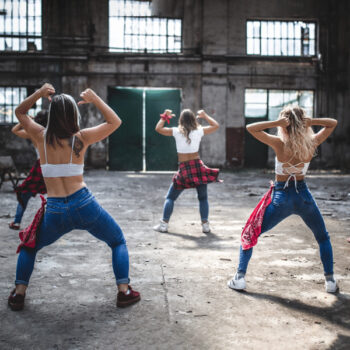Hip hop dance
The hip-hop dance style includes a vibrant and energetic form of expression that originated from the streets of African American and Latino communities in the 1970s. It is closely associated with the hip-hop music genre and has since evolved into a global phenomenon, captivating audiences with its unique blend of rhythm, style, and creativity. In this article, we will explore the meaning of hip-hop dance, its various styles, and its history, and provide insights on how to dance in the hip-hop style.
What is the meaning of hip-hop dance?
Hip-hop dance is more than just a series of movements; it is a cultural movement that encompasses self-expression, storytelling, and a means of connecting with others. It serves as a platform for individuals to share their emotions, experiences, and social commentary through the language of movement. Hip-hop dance provides a voice for marginalized communities, empowering them to express their identities, frustrations, and aspirations.
How would you describe hip-hop dance?
Hip-hop dances can be described as a fusion of various dance styles, including breaking, popping, locking, krumping, and more. It is characterized by its dynamic and fluid movements, intricate footwork, isolations, and improvisation. The style emphasizes individuality and creativity, allowing dancers to incorporate their unique personalities and interpretation of the music into their performances.
What are the 7 different styles of hip-hop dance?
Hip-hop dance is a dynamic and constantly evolving art form that encompasses a wide range of styles and techniques. Over the years, hip-hop dance has evolved and branched out into different sub-genres, each with its unique characteristics, history, and cultural influences. Here are seven different types of hip-hop dance styles that you should know about:
Breaking
Breaking, also referred to as breakdancing, stands as an iconic and widely recognized style within the realm of hip-hop dance. Its roots trace back to the 1970s in the vibrant borough of the Bronx, New York, where it gained momentum among African American and Latino youth. Breaking is distinguished by its awe-inspiring acrobatic maneuvers, encompassing dynamic spins, flips, and freezes, all perfectly synchronized to the infectious beats of funk or hip-hop music.
Popping
Popping is a style of hip-hop dance that originated on the West Coast in the 1970s. It involves the contraction and release of muscles to create sharp, staccato movements, known as pops. Popping is often combined with other styles, such as locking and waving, and is performed to funk or electronic music.
Locking
Locking, a hip-hop dance style that emerged during the 1970s in Los Angeles, showcases a distinctive fusion of fluidity and exuberance. Dancers embody this style through exaggerated movements, featuring prominent arm swings, knee drops, and punctuated freezes or locks. Locking's infectious energy is often accompanied by the grooves of funk or disco music, amplifying its playful and upbeat nature.
Waving
Waving is a style of hip-hop dance that originated in California in the 1970s. It involves fluid, wave-like movements that flow through the dancer's body, often creating the illusion of an invisible wave passing through the body. Waving is often performed to electronic or experimental music and requires a high level of body control and coordination.
Krumping
Krumping, a hip-hop dance style that emerged in the early 2000s in Los Angeles, exudes unparalleled intensity and rawness. It is defined by rapid and aggressive movements, including dynamic chest pops and emphatic arm swings. Krumping finds its natural rhythm in the pulsating beats of hip-hop and electronic music, providing the perfect backdrop for its explosive energy. This dance form serves as a powerful outlet for emotions, allowing dancers to express a wide range of feelings, from profound anger and frustration to unbridled joy.
Tutting
Tutting, an expressive hip-hop dance style that emerged during the 1990s, showcases a mesmerizing interplay of sharp and angular movements. Inspired by the intricate patterns of Egyptian hieroglyphics, this form of dance often involves creating geometric shapes using the arms and hands. Tutting's choreography is beautifully synchronized with electronic or experimental music, adding an element of intrigue and innovation to its performances. Achieving mastery in tutting demands a remarkable level of precision and control, as dancers navigate the intricate formations with meticulous attention to detail.
House
House is a style of hip-hop dance that originated in Chicago in the 1980s. It combines elements of hip-hop, disco, and funk and is characterized by fluid, flowing movements, often performed in a freestyle improvisational manner. House is often performed to house music, a genre of electronic dance music.
History of hip hop dance
Hip-hop dance traces its roots back to the streets of New York City in the 1970s, where it emerged alongside the rise of hip-hop music. It originated as a form of expression within African American and Latino communities, serving as a means of storytelling, cultural exchange, and social commentary. From its humble beginnings in block parties and underground clubs, hip-hop dance gradually gained recognition and popularity worldwide, influencing mainstream dance culture and inspiring countless dancers and choreographers.
Hip-hop dance origin
Hip-hop developed from the African American and Latino communities in New York City in the 1970s. It was a form of self-expression and cultural identity that grew alongside the rise of hip-hop music. The style was heavily influenced by African dance, jazz dance, and the funk styles of the 1970s. It was a way for marginalized communities to reclaim their cultural heritage and express their identities and experiences through movement. Today, hip-hop dance has become a global phenomenon, inspiring countless dancers and choreographers and influencing mainstream dance culture.
Hip-hop dances examples
Some iconic hip-hop dance examples include:
- The "Running Man": A classic movie where the dancer moves their feet back and forth in a running motion while staying in place.
- The "Robot": Inspired by popping, this move imitates the mechanical and robotic movements of a robot.
- The "Dougie": Popularized by the Cali Swag District rap song, this dance involves swaying and rotating movements of the hips and arms.
- The "Moonwalk": Made famous by Michael Jackson, the moonwalk creates an illusion of gliding backward while moving forward.
How to dance hip-hop style?
Dancing hip-hop style requires a combination of rhythm, coordination, and attitude. Here are some tips on how to get started:
- Listen to hip-hop music: Hip-hop dance is all about the music. Start by listening to hip-hop tracks and getting familiar with the rhythm and beats.
- Find inspiration: Watch music videos of the hip-hop dancer and choreographers to get inspired and learn the popular hip-hop dance styles list.
- Practice the basics: Begin with mastering the basic moves of hip-hop dance, such as the bounce, step touch, and body roll.
- Focus on your footwork: Footwork is an essential element of hip-hop dance. Practice different combinations of footwork and incorporate them into your routine.
- Add personal flair: Hip-hop dance is about expressing yourself, so don't be afraid to add your unique style and personality to your movements.
- Work on your attitude: Hip-hop dance is characterized by confidence, swag, and attitude. Practice incorporating these elements into your performance.
- Join hip-hop dance classes or dance studios: Joining a hip-hop dance class can provide you with structure, guidance, and a rock-steady crew of fellow dancers to learn and grow with.
- Practice on the dance floor, create percussive beats, and develop crazy legs.
Hip Hop: Empowering Youth Through Creative Expression
Hip-hop social dancing, beyond its catchy beats and infectious rhythms, serves as a powerful tool for empowering youth and fostering creative expression like a soul train. This cultural movement, born from the streets and rooted in the experiences of marginalized communities, has provided a platform for young individuals to reclaim their narratives, amplify their voices, and effect positive change.
Hip-hop's influence on youth empowerment can be seen in various aspects. Firstly, it offers an avenue for self-expression and creative outlet. Through rap lyrics, street dance moves, graffiti art, and DJing skills, young people can channel their emotions, thoughts, and experiences into their craft. Hip-hop culture encourages authenticity, allowing individuals to share their stories, struggles, and triumphs in a raw and unfiltered manner.
Moreover, hip-hop fosters a sense of community and belonging among young people. It has created a space where individuals can connect with like-minded peers, forms supportive networks, and build a sense of identity. Hip-hop communities often provide mentorship, collaboration opportunities, and platforms for aspiring artists to showcase their talents. These supportive environments offer encouragement, validation, and the chance for young people to find their voice in a world that may otherwise marginalize them.
Features of the hip-hop style
In conclusion, hip-hop dance is a powerful and vibrant form of artistic expression that originated from the streets of African American and Latino communities. It encompasses a wide range of hip-hop dance style names, each with its own unique characteristics and cultural influences. From the acrobatic moves of breaking to the precise isolations of popping and the energetic rhythms of krumping, hip-hop dance offers a diverse and dynamic landscape for hip-hop dancers to explore.
Hip-hop dance is not just about the dance moves; it carries a deep meaning and serves as a platform for self-expression, storytelling, and social commentary. It has the power to give a voice to marginalized communities, allowing them to share their experiences, frustrations, and aspirations with the world.
Throughout hip-hop history, this dance has evolved and spread globally, influencing mainstream dance culture and inspiring countless dancers and choreographers. It continues to evolve and adapt, incorporating new influences and pushing boundaries.
If you're interested in hip-hop dance, remember to listen to the music, practice the basic moves, and add your style and attitude. Joining a dance class or community can provide valuable guidance and a supportive environment to grow as a dancer.
Hip-hop dance is a testament to the power of creativity, rhythm, and cultural exchange. It breaks barriers, transcends borders, and unites people through the universal language of movement. So put on your favorite hip-hop track, embrace the energy, and let your body tell a story through the captivating art form of hip-hop dance.




